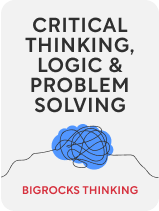

This article is an excerpt from the Shortform book guide to "Critical Thinking, Logic & Problem Solving" by Bigrocks Thinking. Shortform has the world's best summaries and analyses of books you should be reading.
Like this article? Sign up for a free trial here.
What are some common biases and fallacies that you should be aware of? What’s a logic tree, and how can it help you make decisions?
The book Critical Thinking, Logic & Problem Solving explains the process of critical thinking and shows how to apply critical thinking to solve problems more effectively. The book also explores how to craft logical and effective communication and stories.
Continue reading for an overview of this highly practical book.
Overview of Critical Thinking, Logic & Problem Solving
Critical Thinking, Logic & Problem Solving by Bigrocks Thinking is a comprehensive guide on how to use critical thought and logic to maximize your thinking and learning abilities. The book also covers logical problem-solving and communication, enabling you to be a more effective problem-solver and presenter. These skills and techniques can be applied to any aspect of your life that requires thinking, including school, work, and personal relationships.
(Shortform note: The authorship of this book is unclear. There is little information available online about the Bigrocks Thinking group.)
Critical Thinking
The authors define critical thinking as the ability to use specific thought processes to understand concepts, solve problems, and communicate effectively.
They argue that critical thinking is not an inborn trait but rather an ability that can be cultivated and honed. Practice is the most important factor in cultivating critical thinking. Everyone can make use of critical thinking in their daily lives.
The authors detail four steps for critical thinking.
Step 1: Gather Information
The authors explain that, to gather information, you should first identify the topic or question you’re dealing with as well as the circumstances or context surrounding it. Once you understand the parameters of your inquiry, you can begin researching it. To do this you’ll need to gather data, perspectives on the issue, and any additional information that could help you in your thinking process. As you’re gathering information, assess its usefulness.
Make sure you’re getting your information from reliable sources:
- Learn to identify real news versus fake news.
- Analyze your sources to ensure their authors aren’t making assumptions but rather are using reliable data to back up their claims.
- Assess the authority of your source.
Check your sources for bias. The authors list several different types of biases, including the following:
- Anchoring bias means being more likely to believe information that you hear first over the information you gather later.
- Confirmation bias is the tendency to give more credence to information that confirms what you already believe and dismiss information that isn’t in line with your beliefs.
- The halo effect is when you have a positive view of someone or something, and this leads you to view their opinions or claims more positively.
- The Dunning-Kruger effect is when you put too much faith in your own abilities.
Check for logical fallacies. A fallacy is a misunderstanding that interferes with your reasoning. Some common fallacies include:
- The middle ground fallacy. This is when there are two opposite options and you assume that the compromise between the two must be correct. However, if either of the opposite options is incorrect, then the middle ground will also be incorrect.
- False cause, or confusing correlation with causation. Two things that co-occur may not mean that either one caused the other. It’s possible that both factors are caused by a third variable.
- Anecdotal evidence fallacy. This fallacy involves using anecdotes, or isolated examples from real life, as evidence for a larger argument when more general evidence may not support that argument.
Step 2: Analyze
Review the information you’ve gathered to see what arguments you can make from it. To do this, you’ll use inductive reasoning. Here are the steps:
- Identify patterns in your information.
- Identify questions that need to be answered.
- Draw conclusions.
Step 3: Evaluate
Once you’ve formed an argument based on your analysis of your information, it’s time to test that argument and evaluate its validity. The authors recommend that you use deductive reasoning to evaluate your argument. Deductive reasoning is the process of going from a theory to a hypothesis and testing it to see if it’s supported by evidence.
Step 4: Keep Improving
Note things you did correctly or that made the process easier and remember them for next time. If you do this, you’ll constantly improve your critical thinking.
Problem-Solving
Critical thinking helps you learn, understand, and form arguments. Problem-solving incorporates the process of critical thinking but is directed specifically at bridging a gap between your current state and a desired state. There are five steps to problem-solving.
Step 1: Identify the Problem
You can do this using seven basic questions that make up what the authors call the “5W2H” method (five ‘W’ questions and two ‘H’ questions):
- What?
- Where?
- When?
- Who?
- Why?
- How?
- How much or how many?
Another tool for defining your problem is what they call the SCQH (Situation, Complications, Question, and Hypothesis) framework. Follow these four steps:
- Situation: Identify your current situation and its context.
- Complications: What things are not working about the situation?
- Question: What questions do the situation and complication bring up?
- Hypothesis: Come up with some hypotheses that could address your questions.
Step 2: Form Solutions
You can use tools such as logic trees to help you identify solutions. A logic tree is a tool that allows you to visually lay out potential solutions so you can consider them more easily. Begin by writing down your problem or question. Then, add branches that show your options and further branches that provide the details of those options. Here’s an example:
Step 3: Select a Solution
One tool you can use to help you choose is a pros and cons assessment. Rate each item based on how important it is. Once you’ve listed all your pros and cons and given them a weight rating, add up the sum for each column and then subtract the cons sum from the pros sum. If the result is a positive number, this suggests the overall benefit of the option outweighs the negatives.
Step 4: Implement Your Solution
You can use the 5W2H method again to help implement your plan:
- What solution are you going to implement?
- Why is this the best solution?
- Where will it be implemented?
- When does it need to be implemented?
- Who is going to implement it?
- How will it be implemented?
- How much effort or cost will it require?
Step 5: Evaluate the Results
Note what went wrong and what went well, and use that information to make better decisions in the future.
Communication and Storytelling
Many people have excellent ideas but don’t understand how to structure their presentations. The authors advise you to structure your presentations logically and to use stories to persuade and inform your audience.
However, for any form of public speaking, they broadly recommend that you:
- Know your topic.
- Know your audience.
- Make consistent eye contact.
- Ask questions of your audience.
Structure Your Thinking: The Pyramid Principle
Structured thinking is key to effective communication. They recommend the pyramid principle for establishing this structure:
- Explain your main idea.
- Explain your reasoning.
- Explain your evidence.
How to Structure Stories
Storytelling helps your audience understand and remember your ideas. It can also build an emotional connection.
To persuade others, the authors recommend the situation-complication-resolution approach. First, you explain the situation, then the complication (the problem), and then the solution that you’re recommending to them.
To explain information to your audience, you can use the hook-meat-payoff structure. First give your hook, where you pique their interest by letting them know what they can get out of your presentation. Follow that up with the meat, where you explain the topic you’re trying to get across to them. Finally, explain exactly how they can apply your information to their lives.
One of the story structures the authors recommend is the five-act structure, or Freytag’s pyramid, which consists of:
- The exposition, which introduces the context and circumstances of the story
- The rising action, in which you describe the events leading to the conflict
- The climax, which is the high point of your plot when the conflict is greatest
- The falling action, where the conflict gets solved and the moral of the story is revealed
- The denouement, or the end of the story
Another framework they recommend is the Pixar story framework to convey information and evoke emotion. You can outline a story with this framework by filling in the blanks of six sentences:
- “Once upon a time, [blank]. Every day, [blank].” These two establish the setting and context of your story.
- “Then one day, [blank].” This establishes your story’s conflict.
- “Because of that, [blank]. And because of that, [blank].” This introduces your character’s challenge and how it affects them and other characters.
- “Until finally, [blank].” This explains how the character resolved their problem.

———End of Preview———
Like what you just read? Read the rest of the world's best book summary and analysis of Bigrocks Thinking's "Critical Thinking, Logic & Problem Solving" at Shortform.
Here's what you'll find in our full Critical Thinking, Logic & Problem Solving summary:
- A step-by-step guide for improving critical thinking and problem-solving skills
- Tips for conducting better research and finding reliable resources
- How to improve your communication and storytelling skills






